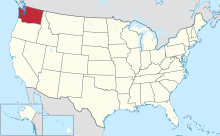 | |
| Number of elections | 33 |
|---|---|
| Voted Democratic | 18 |
| Voted Republican | 14 |
| Voted other | 1[a] |
| Voted for winning candidate | 23 |
| Voted for losing candidate | 10 |
Washington is a state in the Pacific Northwest region of the United States. Since its admission to the Union in 1889, the state has participated in 33 United States presidential elections.[1]
In the 1892 presidential election, the incumbent president Benjamin Harrison received 41.45% of the popular vote and obtained 4 electoral votes from Washington.[2] Before 1932, Washington state leaned towards the Republican Party. Washington state was won by Progressive Party presidential nominee Theodore Roosevelt in 1912, which is the only time it voted for the third party's nominee as of 2023. From 1932 to 1948, Democratic candidates won Washington state in landslide victories due to the Great Depression and the New Deal.[3][4]
From 1952 to 1984, the Democratic nominee won just two of nine elections in Washington state. Since 1984, no Republican candidate has won a presidential election in Washington state. In 2009, American journalist Ron Brownstein referred to Washington and 17 other states collectively as the "Blue Wall" due to its political leaning.[5][6]
Washington state is typically thought of as politically divided by the Cascade Mountains, with Western Washington generally being liberal and Eastern Washington generally being conservative.[7] However, due to Democratic dominance in the Seattle metropolitan area, which has an extremely high population density, Washington state is a blue state in general.[8][9]
Washington state has signed the National Popular Vote Interstate Compact, an interstate compact in which signatories award all of their electoral votes to the winner of the federal-level popular vote in a presidential election, even if there are other candidate won some of individual signatorys' popular vote. However, it has not yet gone into force as of 2023.[10]
Cite error: There are <ref group=lower-alpha> tags or {{efn}} templates on this page, but the references will not show without a {{reflist|group=lower-alpha}} template or {{notelist}} template (see the help page).
- ^ Oldham, Kit (March 1, 2022). "Washington is admitted as the 42nd state to the United States of America on November 11, 1889". HistoryLink. Retrieved June 21, 2023.
- ^ Guide to U.S. Elections 2010, p. 773.
- ^ Davies, Richard O. (1964). "The Politics of Desperation: William A. Hirth and the Presidential Election of 1932". Agricultural History. 38 (4): 226–234. ISSN 0002-1482. JSTOR 3741013. Retrieved June 22, 2023.
- ^ Phillips, Kevin (2015). The Emerging Republican Majority (STU - Student ed.). Princeton University Press. p. 485. ISBN 978-0-691-16324-6. JSTOR j.ctt9qh063. Retrieved June 22, 2023.
- ^ "Clinton's Campaign Is Focused on Battleground States She Doesn't Really Need – The Atlantic". The Atlantic. November 2, 2016.
- ^ Steinhauser, Paul (November 12, 2012). "Holding Democratic 'blue wall' was crucial for Obama victory". CNN. Retrieved June 21, 2023.
- ^ "Red state, blue state: Watch 40 years of political change in Washington". The Seattle Times. September 1, 2016. Retrieved June 27, 2023.
- ^ Brown, Justin (December 8, 2022). "Exploring Washington State's East-West Divide". Battleground. Retrieved June 21, 2023.
- ^ Webley, Kayla (January 15, 2013). "A State Divided: As Washington Becomes More Liberal, Republicans Push Back". Time.
- ^ "Status of National Popular Vote Bill in Each State". National Popular Vote Inc. November 11, 2016. Retrieved June 21, 2023.
© MMXXIII Rich X Search. We shall prevail. All rights reserved. Rich X Search
